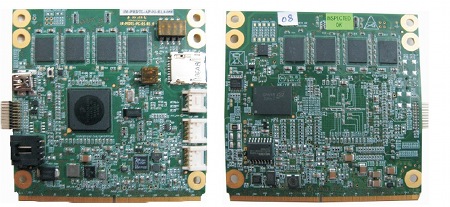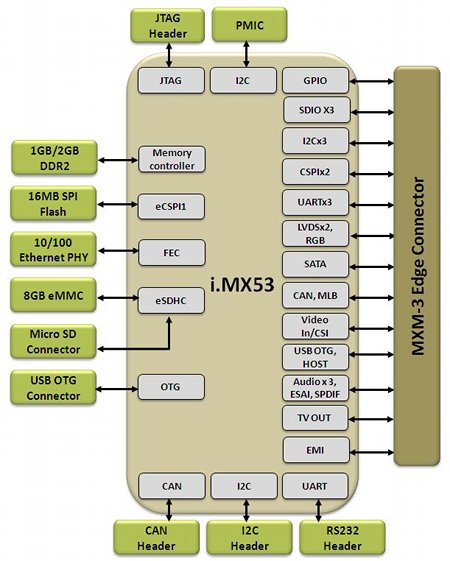Module sports auto-oriented Cortex-A8 processor
Mar 2, 2011 — by LinuxDevices Staff — from the LinuxDevices Archive — 1 viewsiWave Systems announced a COM (computer on module) based on Freescale's i.MX53 SoC (system on chip). The Linux- and Android-ready iW-Rainbow-G11M includes not only the 1GHz, ARM Cortex-A8 processor, but also 1GB of DDR2 RAM and 16MB of flash storage, according to the company.
iWave's iW-Rainbow-G11M employs the i.MX536 SoC that Freescale announced last October. Described at the time as an auto-oriented version of the i.MX535, the chip includes a 1GHz Cortex-A8 CPU core, dual graphics processing units, and a video processor capable of 1080p decoding and 720p encoding "with minimal CPU loading," according to the chipmaker.
Processor capabilities aside, the iW-Rainbow-G11M is a healthy upgrade to iWave's Freescale i.MX51-based iW-Rainbow-G8M (released last year), since it also doubles RAM to 1GB. Onboard flash storage is meanwhile quadrupled to 8GB, according to iWave.

iWave's iW-Rainbow-G11M
(Click to enlarge)
Like the iW-Rainbow-G8M, the G11M employs an Nvidia MXM (Mobile PCI Express Module) connector, as do Qseven modules. There's no implication here that the G11M implements the Qseven bus, nor does iWave provide information about any compatible carrier boards it might be planning to offer. However, the company says the MXM-3 connector lets "anybody … buy this module and quickly develop their own application-specific carrier card."
Peripherals on board the iW-Rainbow-G11M include a 10/100 Ethernet port, an RS232 port, a USB On-The-Go connector, plus headers for I2C, CAN, and JTAG, according to iWave. The 3.34 x 3.34-inch board also has a microSD slot, the company adds.

A block diagram of iWave's iW-Rainbow-G11M
(Click to enlarge)
All other signals travel to and from the outside world via the MXM connector, and include three serial ports, three SDIO interfaces, SATA, plus both analog and digital audio, among others. This is also the path for video input and parallel RGB output, according to iWave.
Features and specifications listed by iWave for the iW-Rainbow-G11M include:
- Processor — 1GHz Freescale i.MX536
- Memory — 1GB of DDR2 RAM, 8GB of flash storage
- Expansion:
- microSD slot
- MXM-3 connector (see below)
- Networking — 10/100 Ethernet
- Other I/O:
- Onboard:
- RS232 port
- I2C header
- CAN header
- USB On-The-Go connector
- JTAG header
- Via MXM-3 connector:
- UART x 3
- I2C x 3
- SDIO x 3
- SPI x 2
- audio x 3
- CAN x 1
- MLB x 1
- S/PDIF x 1
- LVDS x 2
- SATA x 1
- RGB out x 1
- video in x 1
- USB host x 1
- USB On-The-Go x 1
- 17 GPIOs
- Onboard:
- Power requirements — n/s
- Operating range — n/s
- Dimensions — 3.34 x 3.34 inches (85 x 85mm)
Further information
iWave did not cite pricing or availability for the iW-Rainbow-G11M but said the device will support Linux, Android 2.1, Windows Embedded Compact 7, Windows CE 6.0 R3, QNX, and VXWorks. More information may be found on the iW-Rainbow-G11M product page.
This article was originally published on LinuxDevices.com and has been donated to the open source community by QuinStreet Inc. Please visit LinuxToday.com for up-to-date news and articles about Linux and open source.